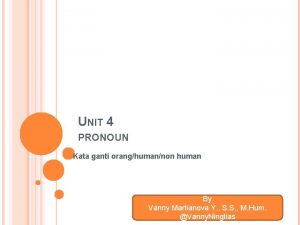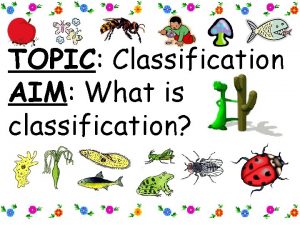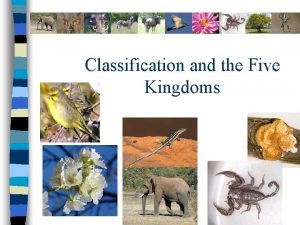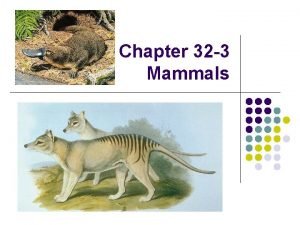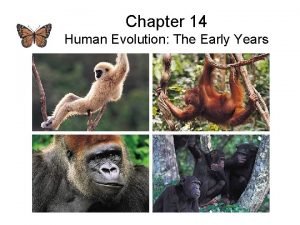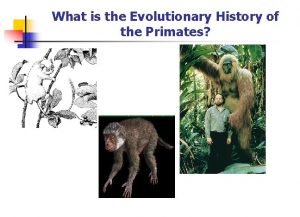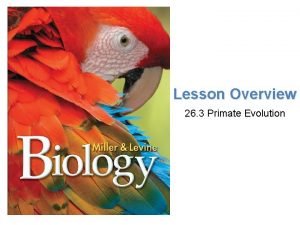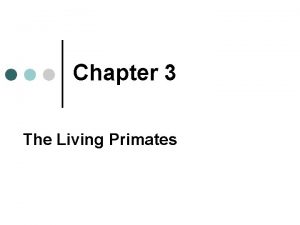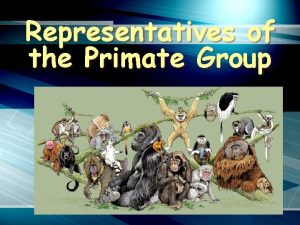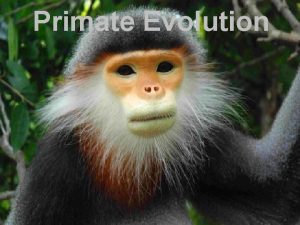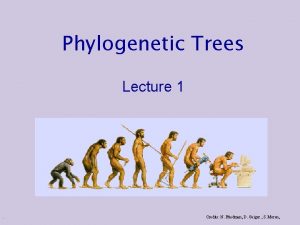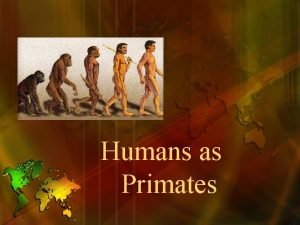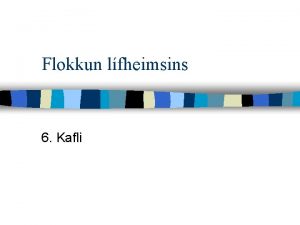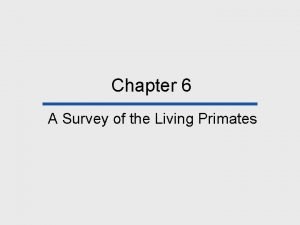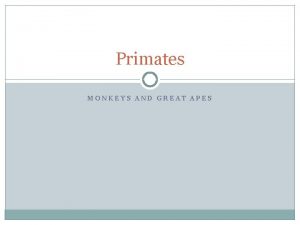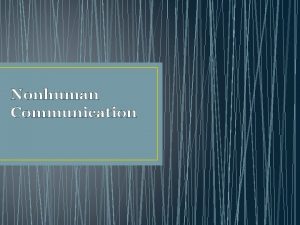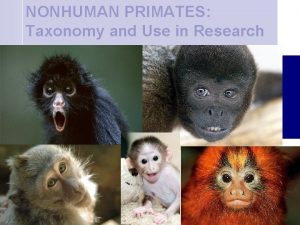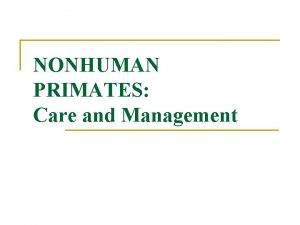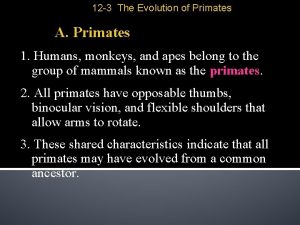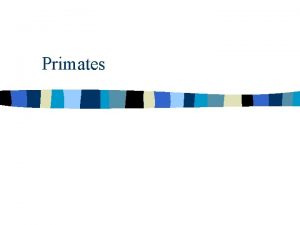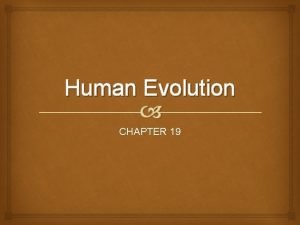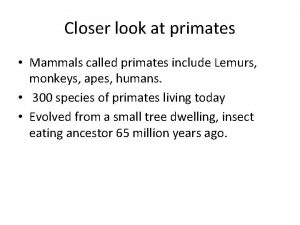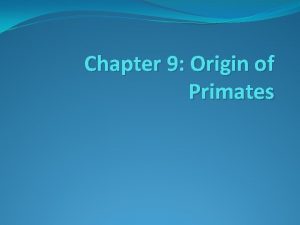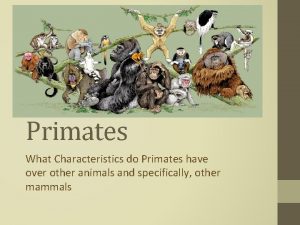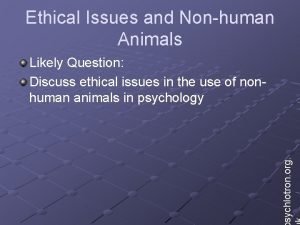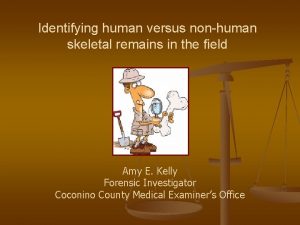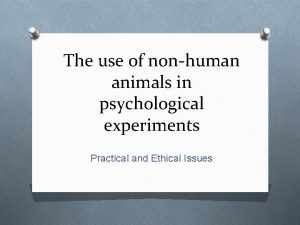Why Study NonHuman Primates Why Study NonHuman Primates


























- Slides: 26

Why Study Non-Human Primates?

Why Study Non-Human Primates? 1. Behaviors universal among modern primates give us clues to our ancestors’ behavior 2. Allows reconstruction of likely social structure, ecology, and intelligence 3. Compare and contrast primate social organizations, communication, intelligence 4. Better understand the environmental factors that led to the divergence of the human lineage 5. Learn how we can preserve the endangered primates

The Evolution of Behavior n Behavior has evolved through natural selection n Individual acts to maximize its own reproductive success n n Natural selection acts on behaviors in the same way it acts on physical characteristics Behavior is the product of complex interactions between genetic and environmental factors

Factors That Influence Behavior n Quantity and quality of foods n Spatial distribution of food resources n Distribution and reliability of water supplies n Body size n Distribution and types of predators

Comparing Behavior n n n HOMOLOGIES = Traits shared by 2 or more species through inheritance from a common ancestor Examples= human arms & bat wings, chimp & bonobo behavior more homologous to humans (diverged 5 mya) v. baboons & humans (diverged 20 mya) ANALOGIES = Traits shared by 2 or more species that are similar in function but not evolutionarily related Example= bat and insect wings The more evolutionarily distant, the less useful the comparison!

Factors That Influence Behavior n n Distribution and types of sleeping sites Activity patterns Relationships with other nonpredator species Impact of human activities

Nonhuman Primate Behavior: Dominance n n n Most primate societies are organized into dominance hierarchies Reduces the amount of actual physical violence Dominant animals can often exert control with only a gesture

Dominance n The relative hierarchical position of an individual in a social group n Maintains group order by determining who gets what, when n Measured by looking at access to limited resources, interactions between individuals n n Influenced by: age, sex, personality, amount of time in the group, intelligence, mother’s status, number of relatives in the group Status is learned

Nonhuman Primate Behavior Communication • Transmission of information by sensory means n n May be unintentional or intentional • Submissive gestures reduce aggression Physical contact and grooming reinforce friendly intentions Used to threaten, invite play or grooming, express dominance, reassure, greet, warn about predators, food • • • Scents, facial expressions and displays, gestures, postures, vocalizations Displays--sequences of repetitious behaviors that communicate emotional states

Nonhuman Primate Behavior Aggression n Conflict develops out of competition for resources Most situations are resolved through submissive and appeasement behaviors Competition for mates frequently results in injury, and occasionally death

Nonhuman Primate Behavior Affiliative Behaviors n Physical contact promotes peace in social groups n Grooming reinforces social bonds n Relationships are crucial and bonds between individuals can last a lifetime n Altruism is common among many primate species

Affiliative Behaviors n n n Reconciliation, consolation, and friendly interactions Based on physical contact (hugging, hand holding, touching, kissing) Nonhuman primates form alliances: two or more animals join together for a common purpose

Play n n n Difficult to define, but you know it when you see it Occurs most commonly in infants and juveniles Requires curiosity (intelligence? ) and can be dangerous…requires parental vigilance Functions to build the individual’s mental, social, and physical skills Time spent in play declines when the individual is stressed (e. g. malnutrition) Adults also play, but usually is oriented toward parenting responsibilities

Nonhuman Primate Behavior Patterns of Reproduction n Females are receptive to males only when they are in estrus Permanent bonding is not common Sometimes, mating relationships are formed, temporary relationships that last while the female is in estrus

Reproductive Strategies n n n Estrus--behavioral and physical changes that indicate that a female is ovulating and receptive to copulation Some primates, including humans, gibbons, and bonobos, mate throughout the female’s cycle and give no obvious signals of ovulation Influences how the two sexes interact and the species’ mating system

Reproductive Strategies • n Females spend almost all of their adult lives pregnant, lactating and/or caring for offspring Males try to secure as many mates as possible to increase genetic contribution to the next generation

Mothers and Infants n n n Basic social unit among primates Monkeys and apes raised in captivity without contact with their own mothers did not know how to care for infants Males do not participate greatly in the rearing of offspring

Nonhuman Primate Cultural Behaviors n n Culture is learned and passed on from one generation to the next May be learned through instruction (common only for humans) and through observation (common in all primates) Cultural traditions are behaviors that become common in the entire group Examples: washing potatoes, tool use, dietary preferences, greeting styles

Primate Behavior Key Terms

n n n anthropocentric Viewing nonhuman primates in terms of human experience; emphasizing the importance of humans over everything else social structure Composition, size and sex distribution of a group of animals dominance hierarchies Systems of social organization wherein individuals within a group are ranked relative to one another

n n n communication Acts that convey information, in the form of a message, to another individual displays Sequences of repetitive behaviors that serve to communicate emotional states affiliative Pertaining to amicable relationships between individuals

n n territories Areas aggressively protected by an animal or group of animals grooming Picking through fur to remove dirt, parasites, and other materials that may be present; common among primates; reinforces social relationships

n n n reproductive strategies Behavior patterns that contribute to individual reproductive success sexual selection Type of natural selection that operates on only one sex within a species altruism Any behavior or act that benefits another individual but poses some potential risk or cost to oneself (adoption, protecting young, helping another in a fight)

Langur: “Takeover” Behavior n n n One adult male, several adult females, offspring; other males live in “bachelor” groups Takeovers involve running out the resident male and killing all unweaned infants Why does this behavior occur?

Langur: Old World Monkey (Vietnam, India, Cambodia)

Langur: “Takeover” Behavior n n Takeover male is attempting to maximize his reproductive success Causes mother to begin sexual cycle Enables takeover male to father offspring faster than if he waited 1 -2 years for weaning to occur Male tenure in the group is short-3 years or less
 The study of human and nonhuman features of earth
The study of human and nonhuman features of earth Chapter 16 section 1 primates study guide answers
Chapter 16 section 1 primates study guide answers Figurative language
Figurative language Kata ganti nonhuman participation
Kata ganti nonhuman participation Special purpose maps
Special purpose maps Pictures
Pictures Classification of primates
Classification of primates Genus and species examples
Genus and species examples Opposable thumb primates
Opposable thumb primates Order primates
Order primates Order primates
Order primates Bipedal
Bipedal Primates
Primates Primate evolution
Primate evolution Primates
Primates Planos terminales en odontopediatria
Planos terminales en odontopediatria Primates
Primates Prosimii
Prosimii Primate evolution
Primate evolution Primates characteristics
Primates characteristics Human phylogenetic tree
Human phylogenetic tree What are primates
What are primates Human evolution
Human evolution Primates
Primates Arboreal hypothesis
Arboreal hypothesis Dont ask why why why
Dont ask why why why Ecological study vs cohort study
Ecological study vs cohort study



